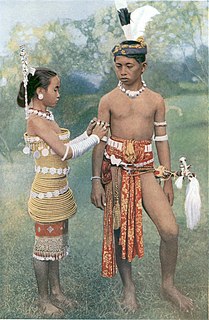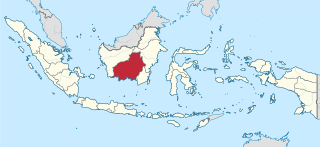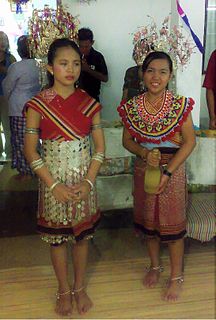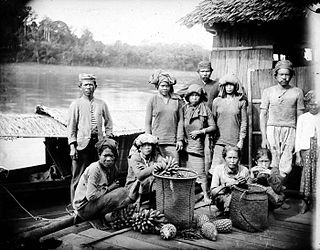
The Dayak or Dyak or Dayuh are one of the native groups of Borneo. It is a loose term for over 200 riverine and hill-dwelling ethnic groups, located principally in the central and southern interior of Borneo, each with its own dialect, customs, laws, territory, and culture, although common distinguishing traits are readily identifiable. Dayak languages are categorised as part of the Austronesian languages. The Dayak were animist in belief; however, since the 19th century there has been mass conversion to Christianity as well as Islam due to the spreading of foreign religions.

Central Kalimantan, is a province of Indonesia. It is one of five provinces in Kalimantan, the Indonesian part of Borneo. Its provincial capital is Palangka Raya and in 2010 its population was over 2.2 million, while the 2015 Intermediate Census showed a rise to 2.49 million and the 2020 Census showed a total of 2.67 million.

Kaharingan is an animistic folk religion professed by many Dayaks in Kalimantan, Indonesia; particularly Central Kalimantan, although many have converted to Christianity or Islam or follow a syncretic religion. It is estimated that most Dayaks follow their ancient animistic religious traditions (Kaharingan), but often claim to belong to one of the recognized religions in Indonesia to prevent discrimination.

The Dayak Iban people are the oldest people on the island of Borneo. According to a study by Chinese experts who studied the human genomes of tribes in Asia, the Iban people are believed to be the first people to migrate to ISEA in ancient times. In fact, the results of a study on the 50,000 -year -old Deep Skull in Sarawak's Niah Cave, Malaysia; were confirmed to be the same as the Iban natives of Borneo themselves.

Gawai Dayak is an annual festival celebrated by the Dayak people in Sarawak, Malaysia and West Kalimantan, Indonesia on 1 and 2 June. It is a public holiday in Sarawak and is both a religious and a social occasion recognised since 1957.

The Krio people are a Dayak ethnic group in West Kalimantan, Indonesia. They live on the upper course of the Krio River and speak the Krio Dayak language.

The Banjar or Banjarese people, are an ethnic group native to the province of South Kalimantan in the country of Indonesia. This ethnic group is also referred to as Bumiputera in Malaysia. They can be found mostly in the Malay Peninsula and Malaysian state of Perak and Sabah.

The Kahayan river, or Great Dayak River, is the second largest river after Barito River in Central Kalimantan, a province of Indonesia in Kalimantan – the Indonesian part of the island of Borneo. With a total length of 658 km (409 mi) and with a drainage basin of 15,500 square kilometers1 in South Kalimantan, Indonesia. Mean annual discharge 1,178 m3/s.1 The provincial capital Palangkaraya lies on the river. The main inhabitants are Dayaks, who practice slash-and-burn rice cultivation and pan for gold on the upper reaches. The lower Kayahan flows through a rich and unusual environment of peat swamp forests, which has been severely degraded by an unsuccessful program to convert a large part of the area into rice paddies, compounded by legal and illegal forestry.

The Ngaju people are an indigenous ethnic group of Borneo from the Dayak group. In a census from 2000, when they were first listed as a separate ethnic group, they made up 18.02% of the population of Central Kalimantan province. In an earlier census from 1930, the Ngaju people were included in the Dayak people count. They speak the Ngaju language.

Bakumpai or Baraki are indigenous people of Borneo and are considered as a sub-ethnic group of the Dayak Ngaju people group with Islamic background. The Bakumpai people first occupy along the Barito riverbanks in South Kalimantan and Central Kalimantan, from Marabahan to Puruk Cahu, Murung Raya Regency. The Bakumpai people first appeared as a newly recognized people group in census 2000 and were made up of 7.51% of Central Kalimantan population, which before this the Bakumpai people were considered as part of the Dayak people in a 1930 census.

Anakletus Tjilik Riwut, more commonly referred to simply as Tjilik Riwut, was an Indonesian journalist, military officer, and politician, who served as the second Governor of Central Kalimantan from 1958 until 1967, as an Independent. He was also a major figure in the Indonesian National Revolution, becoming one of the leaders of the Kalimantan Physical Revolution in Dutch Borneo after the end of World War II, along with Idham Chalid, Hasan Basry, Mohammad Noor, and a number of other decentralized leaders.

Salukat or Saloekat is a traditional quiver of the Mentawai people originating from the Mentawai Islands, Indonesia.

Ot Danum people are a subethnicity of the Dayak people dwelling at the upper reaches of south Kapuas River, and along the Schwaner range, bordering West Kalimantan and Central Kalimantan, Indonesia. They are the most important group of the upper Melawi River and culturally and linguistically the most distinct from the Malay people. Besides, the Malay people, the Ot Danum people are also linguistically distinct from the Ngaju people who live along the middle reaches of Central Kalimantan's great rivers and who are numerically and linguistically the dominant Dayak people group in the area. Just like most Dayak people group, majority of the Ot Danum people also practice Kaharingan religion.

Parang Latok is a sword from Kalimantan, Indonesia, that also functions as a machete.
Ayam pansuh or manuk pansuh is a dish prepared by cooking chicken meat in a bamboo stalk, filled with water, seasonings and covered with tapioca leaves from the cassava plant. The origin of ayam pansuh is unknown, but the Ibans and the Bidayuhs from western Borneo always prepare this dish during festivals, especially during the Gawai Dayak. Ayam pansuh is typical among the people in Sarawak, Malaysia and also in West Kalimantan, Indonesia. There is a plan to introduce the dish into the international market.

Sandung or sandong is the ossuary of the Dayak people of South and Central Kalimantan, Indonesia. The sandung is an integral part of the Tiwah ceremony of the Ngaju people, which is basically a secondary burial ritual where the bones of the deceased are taken from the cemeteries, purified and finally placed in a sandung.

Pisau raut is a whittling knife that is commonly as a tool to prepare the rattan and other fine carving found throughout the entire Malay archipelago. It is well known as an accompanying knife placed in the same sheath with the mandau, a traditional weapon of the Dayak people.

Sumpit or sumpitan are general terms for blowguns, usually tipped with iron spearheads, used for hunting and warfare in the islands of the Philippines, Borneo, and Sulawesi. They were also known as zarbatana by the Spanish.

Katapu or Kalapu is a traditional war cap or helmet used by Dayaks of Borneo. Katapu Kaloi is a sea dayak war cap, made by sewing large fish scales on cap made from a bast-like material.

The Kliau, Keliau or Klau is a traditional shield of the Dayak people of Borneo. It is similar to the shields used by other Dayak people such as the Klebit Bok of the Kenyah. Other names for this shield include: klawang or kelawang and trabai or terabai.






















